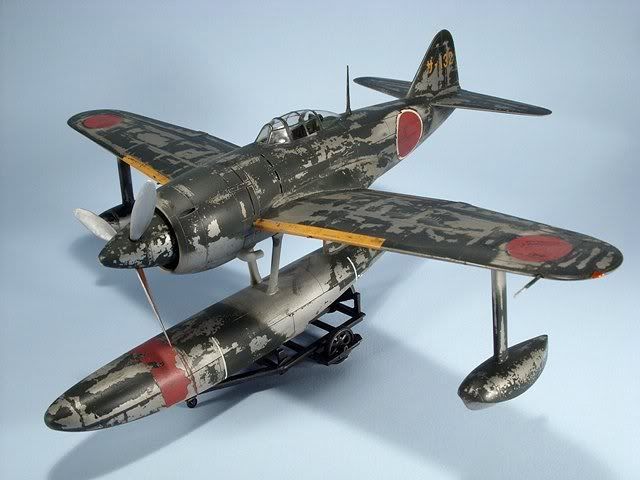Some time in the recent past I saw (I believe on a build thread) some very realistic fabric wheel covers; they appeared chipped and worn with the CDL fabric showing through the painted cover in a sort of cracked/peeling effect. I believe I queried the author on the technique and received a reply but for the life of me can't find the article nor remember the method used.
Apparently "oldtimers" and AMS do not mix well and my presently degraded wireless service isn't helping the problem!
Can anyone point me in the right direction and/or offer some advice on how to achieve the effect?
Thanks,
Lance
Early Aviation
Discuss World War I and the early years of aviation thru 1934.
Discuss World War I and the early years of aviation thru 1934.
Hosted by Jim Starkweather
Wheel Covers-worn/weathered look
lcarroll

Joined: July 26, 2010
KitMaker: 1,032 posts
AeroScale: 1,025 posts

Posted: Friday, June 10, 2011 - 11:27 AM UTC

JackFlash

Joined: January 25, 2004
KitMaker: 11,669 posts
AeroScale: 11,011 posts

Posted: Saturday, June 11, 2011 - 02:06 PM UTC
Ok, was the model you were commenting on 1:32, 1:48. . . Assuming it was allied?
lcarroll

Joined: July 26, 2010
KitMaker: 1,032 posts
AeroScale: 1,025 posts

Posted: Saturday, June 11, 2011 - 03:28 PM UTC
Quoted Text
Ok, was the model you were commenting on 1:32, 1:48. . . Assuming it was allied?
Stephen,
It was 1/32 and, I believe, an Albatros DV or Va . I just noticed that the effect I'm trying to duplicate is the one on Wingnut's DVa, 01 June post showing it on the spinner.
Hope I'm not missing a tree for the forest here, I'Net pretty frustrating presently however the service folks should show up here Monday.
Marc, (Wingnut) can you help? How did you produce the chipped or worn off paint effect on your Albatros??
Cheers,
Lance

wing_nut

Joined: June 02, 2006
KitMaker: 1,212 posts
AeroScale: 468 posts

Posted: Sunday, June 12, 2011 - 03:59 AM UTC
Hey Lance. Good thing you made mention of this in the GB thread. I honestly keep forgetting that there is more to the forum than the GB 
This is another technique I picked up from doing armor. Some aircraft have heard of it but I think the armor guys have been trying to keep it to themselves. OK... ourselves since the past 3 years or so I have been nothing but armor.
Sorry for the long post. This is all the stuff I figured out over time and may aim is to drastically reduce the amount of experimentation you will need to do.
It's called the hair spray technique. The basic principal is hair spray (HS) is put over a base coat and over coated with a second color. The HS is water soluble so taking a brush dipped in water the top layer can be made to flake off.
Once you have decided on the colors get the base coat down and let it cure really well. Any kind of paint works. The wheels and spinner on my Albatros are Alclad II aluminum. But enamels and acrylics work as well. Now you need to decide what the chipping is too look like. Big broad areas or some very fine wear. This determines how heavy the HS coat, what brushes to use and in some case even what type of paint for the top coat.
To get the look you are after, here are the things that affect how the paint comes off.
Amount of HS. A thick coat will dissolve quicker increasing the amount of chipping. I use a pump spray type so I can put some in a color cup and airbrush it for a thin coat or pump it right out of the bottle for a heavy coat. It must be completely dry before the color top coat.
Amount of water. Since this is what gets under the top coat of paint to dissolve the HS, the more water used then more paint will flake off.
Type of top coat paint. The chipping is the easiest with acrylics. The thicker the coat of paint to more work it will take to get it to come off. Enamels will also work but it is harder to get off so it can produce a much finer look for wearing the paint off small object or the edges of things. How long you let it dry too makes a difference. Dry to the touch comes off easier then well cured.
Brush type. I use 3 brushes about 99% of the time. The left one is a round brush with the bristles cut super short to a chisel shape, making it really stiff, good for edges, along panel lines, scratches. The middle and right are 1/4" wide flat bushes with the middle one cut down to about 1/8". Again good for scrubbing but not as aggressive as the round. The right brush is more or less the "basic" brush used most of the time.

Combine the factors above for the effect you want. Heavy HS + light top coat of acrylic just dry to the touch+ a lot of water+the widest brush= lots of peeling. OR very thin HS+ thick enamel allowed to cure+ tiny bit of water+small brush= smallest amount of chipping. You will really need to work to get the paint off in this extreme case.
The spinner and wheels on the D.Va are all middle of the road factors.
A couple of things to be aware of... A heavy coat of paint over a heavy coat of HS will likely crackle in places. This may be of use but you may not want it to happen at all. When using enamels, when they are cured you will likely need to give places for the water to get underneath. Some very light scratches on the surface and at [panels line and letting the water have a chance to work will be needed. And at the opposite end a light with a coat of acrylic, once the water starts working it can really start working, the paint can really start to come off fast. Real fast!
Just a bunch of pics of the different looks you can get.







This is another technique I picked up from doing armor. Some aircraft have heard of it but I think the armor guys have been trying to keep it to themselves. OK... ourselves since the past 3 years or so I have been nothing but armor.
Sorry for the long post. This is all the stuff I figured out over time and may aim is to drastically reduce the amount of experimentation you will need to do.
It's called the hair spray technique. The basic principal is hair spray (HS) is put over a base coat and over coated with a second color. The HS is water soluble so taking a brush dipped in water the top layer can be made to flake off.
Once you have decided on the colors get the base coat down and let it cure really well. Any kind of paint works. The wheels and spinner on my Albatros are Alclad II aluminum. But enamels and acrylics work as well. Now you need to decide what the chipping is too look like. Big broad areas or some very fine wear. This determines how heavy the HS coat, what brushes to use and in some case even what type of paint for the top coat.
To get the look you are after, here are the things that affect how the paint comes off.
Amount of HS. A thick coat will dissolve quicker increasing the amount of chipping. I use a pump spray type so I can put some in a color cup and airbrush it for a thin coat or pump it right out of the bottle for a heavy coat. It must be completely dry before the color top coat.
Amount of water. Since this is what gets under the top coat of paint to dissolve the HS, the more water used then more paint will flake off.
Type of top coat paint. The chipping is the easiest with acrylics. The thicker the coat of paint to more work it will take to get it to come off. Enamels will also work but it is harder to get off so it can produce a much finer look for wearing the paint off small object or the edges of things. How long you let it dry too makes a difference. Dry to the touch comes off easier then well cured.
Brush type. I use 3 brushes about 99% of the time. The left one is a round brush with the bristles cut super short to a chisel shape, making it really stiff, good for edges, along panel lines, scratches. The middle and right are 1/4" wide flat bushes with the middle one cut down to about 1/8". Again good for scrubbing but not as aggressive as the round. The right brush is more or less the "basic" brush used most of the time.

Combine the factors above for the effect you want. Heavy HS + light top coat of acrylic just dry to the touch+ a lot of water+the widest brush= lots of peeling. OR very thin HS+ thick enamel allowed to cure+ tiny bit of water+small brush= smallest amount of chipping. You will really need to work to get the paint off in this extreme case.
The spinner and wheels on the D.Va are all middle of the road factors.
A couple of things to be aware of... A heavy coat of paint over a heavy coat of HS will likely crackle in places. This may be of use but you may not want it to happen at all. When using enamels, when they are cured you will likely need to give places for the water to get underneath. Some very light scratches on the surface and at [panels line and letting the water have a chance to work will be needed. And at the opposite end a light with a coat of acrylic, once the water starts working it can really start working, the paint can really start to come off fast. Real fast!
Just a bunch of pics of the different looks you can get.






lcarroll

Joined: July 26, 2010
KitMaker: 1,032 posts
AeroScale: 1,025 posts

Posted: Sunday, June 12, 2011 - 04:23 AM UTC
Marc,
First, thank you so much for taking the time; this is indeed a long one and I appreciate your efforts to help a fellow hobbyist.
I'll be re-reading this several times and will do some experimenting. It looks to be a very useful technique and I'm sure I'll be using it a lot in future.
Typical of our site; have a problem or question, ask for help, and everyone bends over backwards to help! Thank you again, I'll let you know how it works out and photos in the Campaign Thread as well if I use it on this build. (suspect I will)
Cheers,
Lance
First, thank you so much for taking the time; this is indeed a long one and I appreciate your efforts to help a fellow hobbyist.
I'll be re-reading this several times and will do some experimenting. It looks to be a very useful technique and I'm sure I'll be using it a lot in future.
Typical of our site; have a problem or question, ask for help, and everyone bends over backwards to help! Thank you again, I'll let you know how it works out and photos in the Campaign Thread as well if I use it on this build. (suspect I will)
Cheers,
Lance
 |






